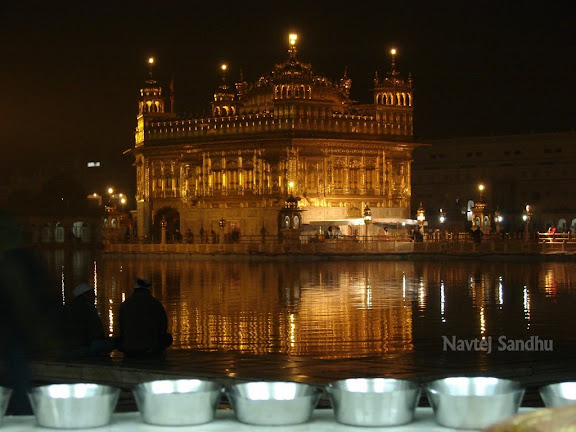The Harmandir Sahib is considered the holiest shrine by Sikhs. The 11th and eternal Guru Sri Guru Granth Sahib Ji is present inside it.
The Sri Guru Granth Sahib is the holiest literature in the Sikh religion, the tenth Guru of Sikhs, Sri Guru Gobind Singh on 7 October 1708 made Shri Guru Granth Sahib Ji the eternal Sikh Guru and the leader of Sikhism. Anywhere in the world where the Guru Granth Sahib is present is equally holy and precious to Sikhs.

Amritsar is located in the Majha region of the Punjab. Majha is also known as the Bari Doab, since it is the Doab (two rivers) or the (fluvial) tract of land which lies between two of the five great rivers of the province, the Ravi and the Beas. As such, Majha lies in the heart of the ancient Punjab region, comprising Gurdaspur, Batala and Tarn Taran Sahib as well as Amritsar. Amritsar is also known as “Sifti Da Ghar” or Adorable Abode.
Guru Arjan Sahib, the Fifth Nanak, conceived the idea of creating a central place of worship for the Sikhs and he himself designed the architecture of Sri Harmandir Sahib. Earlier the planning to excavate the holy tank (Amritsar or Amrit Sarovar ) was chalked out by Guru Amardas Sahib, the Third Nanak, but it was executed by Guru Ramdas Sahib under the supervision of Baba Budha ji.[...]

Originally built during AD 1574, the site of the temple was surrounded by a small lake in a thin forest. The third of the six grand Mughals, emperor Akbar, who visited the third Sikh Guru, Guru Amar Das, at the neighbouring town of Goindval was so impressed by the way of life in the town that he gave a jagir (the land and the revenues of several villages in the vicinity) to the Guru’s daughter Bhani as a gift on her marriage to Bhai Jetha, who later became the fourth Sikh Guru, Guru Ram Das. Guru Ram Das enlarged the lake and built a small township around it. The town was named after Guru Ram Das as “Guru Ka Chak”, “Chak Ram Das” or “Ram Das Pura”.
During the leadership of the fifth Guru, Guru Arjan Dev Ji (1581–1606), the full-fledged Temple was built. In December 1588 the great Muslim Sufi saint of Lahore, Hazrat Mian Mir, a close friend of Guru Arjan Dev Ji, was asked to lay the corner stone (December 1588).[1][6] The story has been told that a mason then straightened the stone, to which Guru Arjan said, as you have just undone the work of such a holy man, who knows what disaster might come to the Harmandir Sahib.
This story has been used to offer a reason why the temple has been attacked so many times by the Afghans and Mughals and even Inspected by force by Indian Army in 1984, during Operation Bluestar, which laid the foundation stone of Khalistan, the proposed rebellious Sikh Homeland. The temple was completed in 1604. Guru Arjan Dev Ji, installed the Adi Granth in it and appointed Baba Buddha Ji as the first Granthi (Reader) of the temple on August 1604.
Unlike erecting the structure on the higher level (a tradition in many religions Temple architecture), Guru Arjan Sahib got it built on the lower level and unlike other Temples having only one gate for the entrance and exit, Guru Sahib got it open from four sides. Thus he created a symbol of new faith, Sikhism. Guru Sahib made it accessible to every person without any distinction of Caste, creed, sex and religion.
The building work completed in August/September,1604. Guru Arjan Sahib installed newly created Guru Granth Sahib, in Sri Harmandir Sahib and appointed Baba Budha ji as its first Granthi.
Sri Harmandir Sahib, is built on a 67ft. square platform in the centre of the Sarovar (tank). The temple itself is 40.5ft. square. It has a door each on the East, West, North and South. The Darshani Deori (an arch) stands at the shore end of the causeway. The door frame of the arch is about 10ft in height and 8ft 6inches in breath. The door panes are decorated with artistic style. It opens on to the causeway or bridge that leads to the main building of Sri Harmandir Sahib. It is 202 feet in length and 21 feet in width.
The bridge is connected with the 13 feet wide ‘Pardakshna’ (circumambulatory path). It runs round the main shrine and it leads to the ‘Har ki Paure’ (steps of God). On the first floor of ‘Har ki Paure’, there is continuous reading ofShri Guru Granth Sahib.
http://tigerstylemicky.blogspot.com
http://tigerstyleinfocom.blogspot.com






